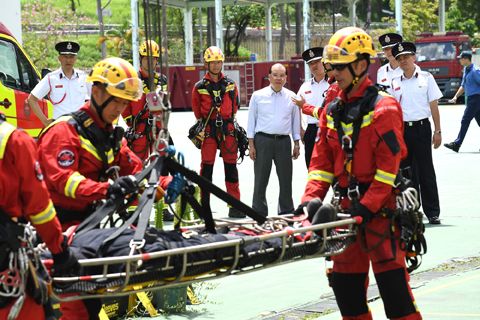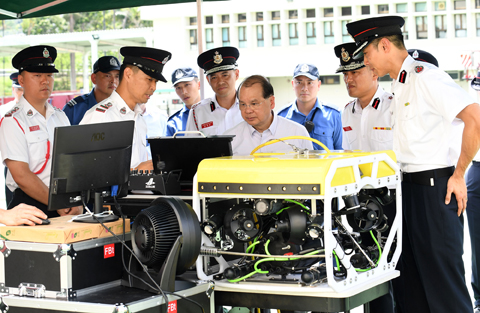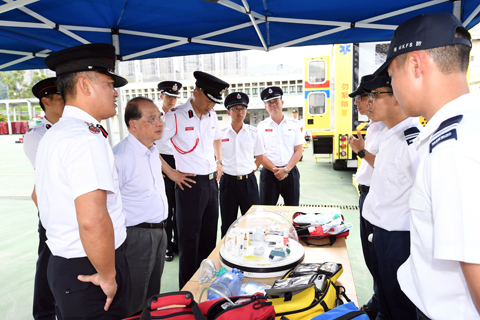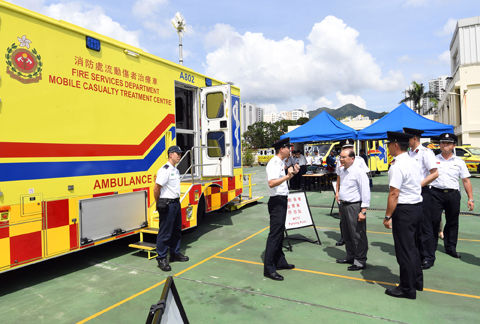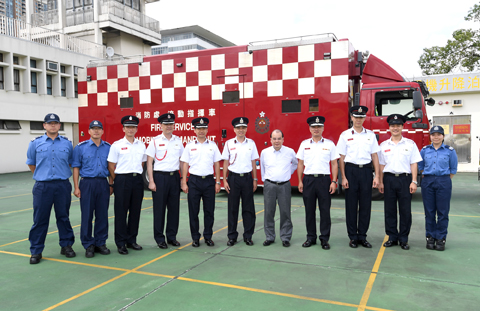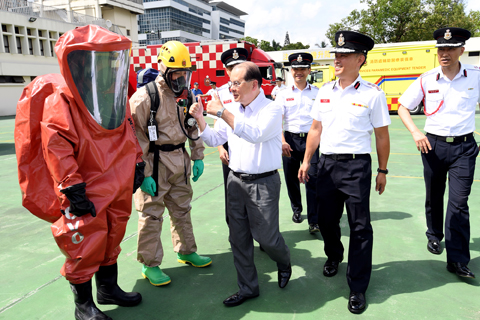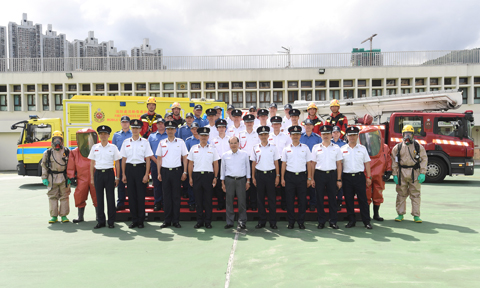Fire Services Department: Tackle new challenges with innovation and enhancement
4 August 2019

|
Last Wednesday (31 July), the Hong Kong Observatory issued the first typhoon signal No. 8 of the year when Typhoon Wipha approached and brought heavy showers and squally thunderstorms to Hong Kong. In the face of more frequent extreme weather events in recent years, the Government will step up its disaster prevention, emergency response and recovery work.
Following the onslaught of Super Typhoon Mangkhut on the city last year, the Government completed a review of the handling of super typhoons. An inter-departmental exercise was held to try out precaution arrangements as early as May this year. Over 30 bureaux, departments and external parties involved in the handling of natural disasters participated in the exercise, which simulated a super typhoon scenario in Hong Kong to test the decision-making, preparedness, response and recovery capabilities of relevant bureaux and departments.
When Hong Kong is affected by super typhoons or other natural disasters of a substantial scale, the Government will immediately activate a high-level steering committee to oversee the preparedness, emergency response and recovery work of various departments. It will also implement the new arrangements for resumption of work if an “extreme conditions” announcement is issued after cancellation of typhoon signal No. 8. Fortunately, Wipha had relatively minor effects on Hong Kong.
Super typhoons are so highly destructive that rescue operation must be initiated without delay. In the light of the damage done by super typhoons Hato and Mangkhut, various disciplinary services departments have strengthened the training for staff to get prepared for typhoon seasons. The fire and ambulance personnel are an important part of the forces.
In an ever changing society with an ageing population, the fire and ambulance personnel face many challenges. Public demands for the services of the Fire Services Department (FSD) are expected to increase. The number of emergency calls received by the FSD increased from 104 459 in 2009 to 121 164 in 2018, representing a rise of 16%. In 2018, the total number of ambulance calls exceeded 800 000 (804 685 cases), an increase of 22% as compared with 659 289 cases in 2009.
The FSD has pledged to provide quick and efficient services. In 2018, its rates of achieving the performance pledges for responding to building fire calls and emergency ambulance calls were both above the set target of 92.5%. The target response time for fire calls is within six minutes for built-up areas and within nine to 23 minutes for areas of dispersed risks or isolated developments. For emergency ambulance calls, the target response time is within 12 minutes.
In emergency cases where somebody around you is suffering from choking, dizziness or cardiac/respiratory arrest, or is in labour while waiting anxiously and patiently for an ambulance, what should you do? At such critical moments, the FSD’s post-dispatch advice (PDA) service comes in handy.
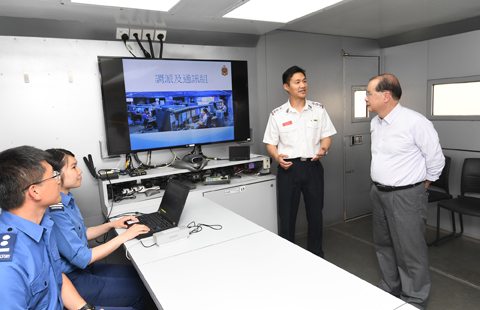
|
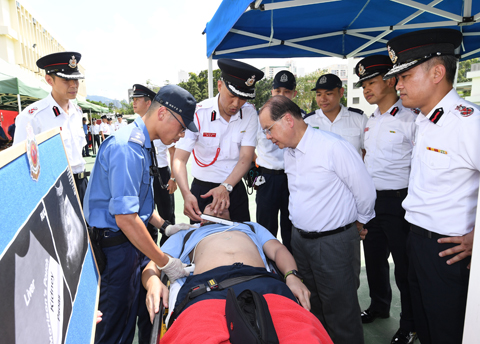
|
In brief, PDA service provides first aid advice to callers when ambulances are being dispatched. Such advice can help callers handle patients and stabilise their injuries or illness conditions before the arrival of an ambulance, thereby reducing delay of treatment and increasing survival rates.
The FSD offers PDA for more than 1 600 times per day on average, accounting for about 90% of all emergency ambulance calls. In some cases, lives are saved and there are many touching stories to tell. When a patient is saved, his whole family is saved too.
To give support to frontline colleagues and learn more about the work of the fire and ambulance personnel, I visited Shatin Fire Station in June. During my visit, the staff shared two touching stories with me. In one case, a father-to-be called the Fire Services Communications Centre (FSCC), saying that his wife was about to give birth at home. After dispatching an ambulance in response to his call, the Mobilising and Communications Group (MCG) staff comforted him while giving him instructions according to the system's first aid advice. Eventually, he helped his wife deliver the baby before the ambulance arrived. It was heartening to see that the mother and her newborn were safe and well.
In the other case, a woman called the FSCC, saying that her husband passed out at home when moving house. Without any first aid experience, she followed the instructions of the MCG personnel and applied cardiopulmonary resuscitation to her husband until the ambulance arrived. In the end, her husband survived. When her husband was in hospital, the staff there told her that he might not have survived without her timely first aid.
Hong Kong has a well-trained and well-equipped emergency fire brigade and ambulance team. Still, it needs to continue recruiting new staff to meet the long-term development needs of the community. In 2018, the FSD recruited 627 fire and ambulance personnel. It is estimated that 819 staff will be recruited this year.
Located at Pak Shing Kok, Tseung Kwan O and commissioned in 2016, the Fire and Ambulance Services Academy (FASA) is a training academy dedicated for training fire and ambulance personnel. The academy is well-equipped by international standards to provide comprehensive foundation and continuous training for both newly recruited and serving fire and ambulance personnel. The FASA also offers professional and diversified training, including the Basic Firefighting Course, the Pre-hospital, Trauma Life Support and Treatment Exchange Workshop, and the Compartment Fire Behaviour Training Technical Exchange Programme, to the fire and ambulance personnel from the Mainland and overseas places (including Korea, Singapore and Vietnam). Besides, the FASA provides professional training courses on firefighting, rescue and ambulance services for other government departments or private organisations (such as the Hong Kong Police Force, the Customs and Excise Department, the Mass Transit Railway Corporation Limited and the Scout Association of Hong Kong). Since its opening, the FASA has provided various training for over 2 100 people from the Mainland, overseas places and the territory.
The fire and ambulance personnel have been making continuous efforts to improve rescue strategies and equipment, enhance quality and efficiency, and maintain a high degree of professionalism on all fronts, including firefighting and rescue, fire protection, ambulance services, and mobilising and communications. They have given their best to serve the community and meet every challenge.


